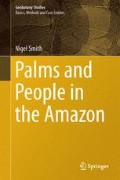Abstract
The most important product of this palm is the fruit which is highly prized for making juice. The enormous fruit bunches, similar in shape to horse tails, are cut in upland forests in the northern and western parts of the Amazon Basin. The palm also occurs a little south of the Amazon River in certain places. Some stands of the palm in forest are likely vestiges of human intervention. Indeed, the palm has a close affinity with some archaeological sites that contain anthropogenic dark earth. In addition to fruit, palmito is harvested from the palm and the strong wood is used to make bows. Petiole strips are used to make a sleeve-like press for manioc dough and the fronds are fashioned into make-shift baskets for carrying produce and game.
Access this chapter
Tax calculation will be finalised at checkout
Purchases are for personal use only
References
Albert B, Milliken W (2009) Uhiri a: a terra-floresta Yanomami. Instituto Sociambental (ISA)/Institut de Recherche pour le Devéloppement, São Paulo
Anderson AB (1977) Os nomes e usos de palmeiras entre uma tribo de índios Yanomama. Acta Amazon 7(1):5–13
Brum HD, Nascimento HEM, Laurance WF et al (2008) Rainforest fragmentation and the demography of the economically important palm Oenocarpus bacaba in central Amazonia. Plant Ecol 199:209–215
Campbell DG (1992) A comparison of the phytosociology and dynamics of three floodplain (várzea) forests of known ages, Rio Juruá, western Brazilian Amazon. Bot J Linn Soc 108:213–237
Carvalho MR, Reesink EB (1993) Ecologia e sociedade: uma breve introdução aos Kanamari. In: Sociedades indígenas e transformações ambientais. Núcleo de Meio Ambiente, Universidade Federal do Pará, Belém, pp 113–153
Chaumeil J-P (1998) Ver, saber, poder: el chamanismo de los Yagua de la Amazonía Peruana. CAAAP/IFEA/CAEA-CONICET, Lima
Clement CR, McCann JM, Smith NJH (2003) Agrobiodiversity in Amazonia and its relationship with dark earths. In: Lehmann J, Kern DC, Glaser B, Woods WI (eds) Amazonian dark earths: origin, properties, management. Kluwer, Dordrecht, pp 159–178
Fock N (1963) Waiwai: religion and society of an Amazonian tribe. National Museum, Copenhagen
Gertsch J, Stauffer FW, Narváez A, Sticher O (2002) Use and significance of palms (Arecaceae) among the Yanomamï in southern Venezuela. J Ethnobiol 22(2):219–246
Giacone A (1949) Os Tucanos e outros tribus do Rio Uaupés, afluente do Negro-Amazonas: notas etnográficas e folclóricos de um missionário Salesiano. Imprensa Oficial do Estado, São Paulo
Henderson A (1995) The palms of the Amazon. Oxford University Press, New York
Hiraoka M, Yamamoto S, Matsumoto E et al (2003) Contemporary use and management of Amazonian dark earths. In: Lehmann J, Kern DC, Glaser B, Woods W (eds) Amazonian dark earths: origin, properties, management. Kluwer, Dordrecht, pp 387–406
Lima D (2006) Vamos cuidar da nossa terra. Universidade Federal do Minas Gerais, Belo Horizonte
Mans J (2012) Amotopoan trails: a recent archaeology of Trio movements. Sidestone Press, Leiden
Mesa LI (2011) Etnobotánica de palmas en la Amazonia Colombiana: comunidades indígenas Piapocos del río Guaviare, como estudio de caso. Masters’ thesis, Universidad Nacional de Colombia, Facultad de Ciencias, Bogotá
Milliken W, Miller RP, Pollard SR, Wandelli EV (1992) The ethnobotany of the Waimiri Atroari Indians of Brazil. Royal Botanic Gardens, Kew
Nimuendajú C (1952) The Tukuna. University of California Press, Berkeley
Ramos JB (2012) Passaros-adornos dos filhos da cobra de pedra (Tuyuka). Instituto Sociambental, São Paulo
Rondón JA (2003) Vocablos Piaroa de algunas artesenías de origen forestal del Estado Amazonas, Venezuela. Rev For Lat 34:71–86
Roquette-Pinto E (1950) Rondônia. Companhia Editora Nacional, São Paulo
Saffirio G, Scaglion R (1982) Hunting efficiency in acculturated and unacculturated Yanomama villages. J Anthropol Res 38(3):315–327
Spruce R (1853a) Botanical objects communicated to the Kew Museum, from the Amazon River, in 1851. In: Hooker WJ (ed) Hooker’s journal of botany and Kew Garden miscellany, vol 5. Lovell Reeve, London, pp 169–177
Velthem LH (1998) A pele de Tuluperê. Museu Paraense Emílio Goeldi, Belém
Wallace AR (1853) Palm trees of the Amazon and their uses. John Van Voorst, London
Author information
Authors and Affiliations
Rights and permissions
Copyright information
© 2015 Springer International Publishing Switzerland
About this chapter
Cite this chapter
Smith, N. (2015). Oenocarpus bacaba . In: Palms and People in the Amazon. Geobotany Studies. Springer, Cham. https://doi.org/10.1007/978-3-319-05509-1_49
Download citation
DOI: https://doi.org/10.1007/978-3-319-05509-1_49
Published:
Publisher Name: Springer, Cham
Print ISBN: 978-3-319-05508-4
Online ISBN: 978-3-319-05509-1
eBook Packages: Earth and Environmental ScienceEarth and Environmental Science (R0)

